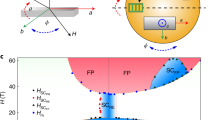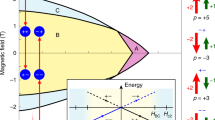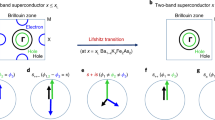Abstract
A change in ‘symmetry’ is often observed when matter undergoes a phase transition—the symmetry is said to be spontaneously broken. The transition made by underdoped high-transition-temperature (high-Tc) superconductors is unusual, in that it is not a mean-field transition as seen in other superconductors. Rather, there is a region in the phase diagram above the superconducting transition temperature Tc (where phase coherence and superconductivity begin) but below a characteristic temperature T* where a ‘pseudogap’ appears in the spectrum of electronic excitations1,2. It is therefore important to establish if T* is just a cross-over temperature arising from fluctuations in the order parameter that will establish superconductivity at Tc (refs 3, 4), or if it marks a phase transition where symmetry is spontaneously broken5,6,7,8,9,10. Here we report that, for a material in the pseudogap state, left-circularly polarized photons give a different photocurrent from right-circularly polarized photons. This shows that time-reversal symmetry is spontaneously broken11 below T*, which therefore corresponds to a phase transition.
This is a preview of subscription content, access via your institution
Access options
Subscribe to this journal
Receive 51 print issues and online access
$199.00 per year
only $3.90 per issue
Buy this article
- Purchase on Springer Link
- Instant access to full article PDF
Prices may be subject to local taxes which are calculated during checkout




Similar content being viewed by others
References
Ding, H. et al. Spectroscopic evidence for a pseudogap in the normal state of underdoped high-Tc superconductors. Nature 382, 51–54 (1996).
Loeser, A. G. et al. Excitation gap in the normal state of underdoped Bi2Sr2CaCu2O8+δ . Science 273, 325–329 (1996).
Randeria, M., Trivedi, N., Moreo, A. & Scalettar, R. T. Pairing and spin gap in the normal state of short coherence length superconductors. Phys. Rev. Lett. 69, 2001–2004 (1992).
Emery, V. J. & Kivelson, S. A. Importance of phase fluctuations in superconductors with small superfluid density. Nature 374, 434–437 (1995).
Varma, C. M. Non-Fermi-liquid states and pairing instability of a general model of copper oxide metals. Phys. Rev. B 55, 14554–14580 (1997).
Varma, C. M. Pseudogap phase and the quantum-critical point in copper-oxide metals. Phys. Rev. Lett. 83, 3538–3541 (1999).
Chakravarty, S., Laughlin, R. B., Morr, D. K. & Nayak, C. Hidden order in the cuprates. Phys. Rev. B 63, 094503-1–094503-10 (2001).
Tallon, J. L. & Loram, J. W. The doping dependence of T*—what is the real high-Tc phase diagram? Physica C 349, 53–68 (2001).
Hsu, T. C., Marston, J. B. & Affleck, I. Two observable features of the staggered-flux phase at nonzero doping. Phys. Rev. B 43, 2866–2877 (1991).
Ivanov, D. A., Lee, P. A. & Wen, X.-G. Staggered-vorticity correlations in a lightly doped t-J model: A variational approach. Phys. Rev. Lett. 84, 3958–3961 (2000).
Varma, C. M. Proposal for an experiment to test a theory of high-temperature superconductors. Phys. Rev. B 61, R3804–R3807 (2000).
Höchst, H., Patel, R. & Middleton, F. Multiple-reflection lambda/4 phase-shifter—a viable alternative to generate circular-polarized synchrotron radiation. Nucl. Instrum. Methods Phys. Res. A 347, 107–114 (1994).
Dubbs, R. et al. Circular dichroism in photoelectron angular distributions from oriented linear molecules. Phys. Rev. Lett. 54, 1249–1251 (1985).
Venus, D. Magnetic circular dichroism in angular distributions of core-level photoelectrons. Phys. Rev. B 48, 6144–6151 (1993).
Simon, M. E. & Varma, C. M. Detection of time-reversal breaking state in normal state of cuprate metals.Preprint cond-mat/0201036 at 〈http://xxx.lanl.gov〉 (2002).
Ding, H. et al. Electronic excitations in Bi2Sr2CaCu2O8: Fermi surface, dispersion, and absence of bilayer splitting. Phys. Rev. Lett. 76, 1533–1536 (1996).
Randeria, M. et al. Momentum distribution sum rule for angle-resolved photoemission. Phys. Rev. Lett. 74, 4951–4954 (1995).
Acknowledgements
We thank M. Randeria for discussions, and T. Kubala, G. Rogers and M. Bissen for their help with the polarizer. This work was supported by the US NSF and the US Department of Energy—Basic Energy Sciences. The Synchrotron Radiation Center is supported by the NSF. S.R. is supported by the Swiss NSF.
Author information
Authors and Affiliations
Ethics declarations
Competing interests
The authors declare that they have no competing financial interests
Rights and permissions
About this article
Cite this article
Kaminski, A., Rosenkranz, S., Fretwell, H. et al. Spontaneous breaking of time-reversal symmetry in the pseudogap state of a high-Tc superconductor. Nature 416, 610–613 (2002). https://doi.org/10.1038/416610a
Received:
Accepted:
Issue Date:
DOI: https://doi.org/10.1038/416610a
This article is cited by
-
Discovery of orbital ordering in Bi2Sr2CaCu2O8+x
Nature Materials (2024)
-
Topological spin texture in the pseudogap phase of a high-Tc superconductor
Nature (2023)
-
Hidden magnetic texture in the pseudogap phase of high-Tc YBa2Cu3O6.6
Communications Physics (2022)
-
Explaining the pseudogap through damping and antidamping on the Fermi surface by imaginary spin scattering
Communications Physics (2022)
-
Nematicity in a cuprate superconductor revealed by angle-resolved photoemission spectroscopy under uniaxial strain
npj Quantum Materials (2021)
Comments
By submitting a comment you agree to abide by our Terms and Community Guidelines. If you find something abusive or that does not comply with our terms or guidelines please flag it as inappropriate.



